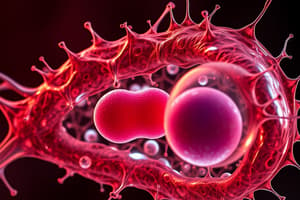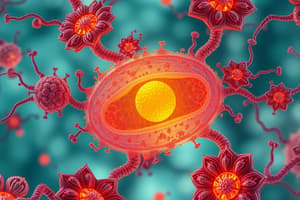Podcast
Questions and Answers
Which mechanism primarily directs proteins to lysosomes for degradation?
Which mechanism primarily directs proteins to lysosomes for degradation?
- Mannose-6-phosphate tags (correct)
- Signal recognition particles
- Nuclear localization signals
- Ribosome association signals
What role do nuclear pore complexes play in nuclear import?
What role do nuclear pore complexes play in nuclear import?
- They synthesize proteins in the nucleus.
- They degrade misfolded proteins in the nucleus.
- They store genetic material within the nuclear envelope.
- They facilitate the transport of proteins across the nuclear envelope. (correct)
What is a key characteristic of receptor-mediated endocytosis?
What is a key characteristic of receptor-mediated endocytosis?
- It selectively takes up molecules via specific receptors. (correct)
- It is an irreversible process.
- It solely involves small molecules.
- It does not require energy input.
Which statement best describes the endocytic pathway?
Which statement best describes the endocytic pathway?
How are proteins typically synthesized in the endoplasmic reticulum?
How are proteins typically synthesized in the endoplasmic reticulum?
Which of the following describes a role of the Golgi complex?
Which of the following describes a role of the Golgi complex?
What is the function of GTPases in nuclear import?
What is the function of GTPases in nuclear import?
Which of the following is NOT a type of transport mechanism for proteins?
Which of the following is NOT a type of transport mechanism for proteins?
What is the primary role of sorting signals in protein targeting?
What is the primary role of sorting signals in protein targeting?
Which ribosome type synthesizes proteins destined for the lysosome?
Which ribosome type synthesizes proteins destined for the lysosome?
What initiates the binding of the ribosome complex to the SRP receptor during protein synthesis in the ER?
What initiates the binding of the ribosome complex to the SRP receptor during protein synthesis in the ER?
Which process utilizes clathrin-coated vesicles for transport?
Which process utilizes clathrin-coated vesicles for transport?
In the context of protein export from the ER, what is the vesicular transport mechanism called that moves proteins towards the Golgi?
In the context of protein export from the ER, what is the vesicular transport mechanism called that moves proteins towards the Golgi?
Which protein coats are specifically associated with retrograde transport from the Golgi back to the ER?
Which protein coats are specifically associated with retrograde transport from the Golgi back to the ER?
What is the function of the translocon during protein synthesis in the ER?
What is the function of the translocon during protein synthesis in the ER?
What characterizes the two types of ribosomes in terms of the locations of synthesized proteins?
What characterizes the two types of ribosomes in terms of the locations of synthesized proteins?
What would happen to a protein without a sorting signal?
What would happen to a protein without a sorting signal?
Which component is crucial for recognizing an ER signal sequence during the protein synthesis process?
Which component is crucial for recognizing an ER signal sequence during the protein synthesis process?
What is the first step in the lysosomal enzyme targeting process?
What is the first step in the lysosomal enzyme targeting process?
Which component mediates the selective import of proteins into the nucleus?
Which component mediates the selective import of proteins into the nucleus?
What characterizes receptor-mediated endocytosis?
What characterizes receptor-mediated endocytosis?
Which process involves the ingestion of fluids and small molecules?
Which process involves the ingestion of fluids and small molecules?
In the mechanism of nuclear import, what role does Ran-GTP play?
In the mechanism of nuclear import, what role does Ran-GTP play?
What is formed when clathrin-coated vesicles fuse with late endosomes during lysosome formation?
What is formed when clathrin-coated vesicles fuse with late endosomes during lysosome formation?
Which signal assists in the import of proteins into the nucleus?
Which signal assists in the import of proteins into the nucleus?
What is the pH level approximately at which lysosomal acid hydrolases function?
What is the pH level approximately at which lysosomal acid hydrolases function?
How are proteins synthesized in the endoplasmic reticulum targeted for lysosomes?
How are proteins synthesized in the endoplasmic reticulum targeted for lysosomes?
What initiates the ingestion of large particles during phagocytosis?
What initiates the ingestion of large particles during phagocytosis?
Flashcards are hidden until you start studying
Study Notes
Intracellular Transport Pathway
- Intracellular transport involves movement of cargo within cells and between organelles and compartments.
Ribosomes and Protein Synthesis
- Protein synthesis occurs on ribosomes, which are essential for translating mRNA into proteins.
- Two types of ribosomes:
- Free ribosomes: Located in cytosol, synthesizing proteins for the nucleus, mitochondria, and peroxisomes.
- Membrane-bound (ER) ribosomes: Target proteins for the endoplasmic reticulum (ER), Golgi, endosomes, lysosomes, nuclear membrane, plasma membrane, and secretion.
- Most animal cell proteins are synthesized in the ER.
Sorting Signals
- Sorting signals are specific amino acid sequences that direct proteins to their correct destinations within the cell.
- Example: ER retention sequence KDEL (Lys-Asp-Glu-Leu).
- Absence of a signal directs the protein to the cytosol.
Endoplasmic Reticulum (ER)
- The ER is crucial for protein synthesis in the cell.
- Components of ER synthesis:
- Signal Recognition Particle (SRP): Binds to the ER signal sequence.
- SRP Receptor: Located on ER membrane, facilitates ribosome binding.
- Mechanism involves SRP recognizing the ER signal sequence, binding to the ribosome complex, inserting polypeptides into membrane channels, and releasing them into the ER lumen.
ER Export and Transport Types
- ER Exit Site (ERES) specializes in vesicle budding for proteins with export signals.
- Transport pathways:
- Anterograde: From ER to Golgi using COPII coats.
- Retrograde: From Golgi to ER using COPI coats.
- Clathrin-coated pathways: Involves endocytic and exocytic transport.
Vesicles for Protein Transport
- Proteins are transported in vesicles through vesicle budding and fusion processes.
- Vesicles utilize cytoskeletal elements for effective transport.
Clathrin Coats and Vesicle Budding
- Vesicles have protein coats for budding from membranes (ER, Golgi, plasma membrane).
- Clathrin-coated vesicles are involved in outward budding from the Golgi and inward budding from the plasma membrane.
Nuclear Import
- Nuclear envelope structure supports selective import/export of proteins.
- Nuclear pore complexes utilize nuclear localization signals (NLS) for targeting proteins.
- Importins recognize NLS and transport proteins into the nucleus in conjunction with GTP-binding protein Ran.
Endocytic Pathway
- The endocytic pathway permits the inward movement of cargo:
- Phagocytosis: Ingestion of large particles by macrophages.
- Pinocytosis: Ingestion of fluids and small molecules.
- Receptor-mediated endocytosis selectively internalizes metabolites, hormones, and proteins through receptor-ligand interactions, often using clathrin-coated vesicles.
Lysosome Targeting
- Sequential transport pathway: ER → Golgi → Endosomes → Lysosomes.
- Lysosomal enzymes are tagged with mannose-6-phosphate (M6P) for targeting.
- Clathrin-coated vesicles facilitate the transport of hydrolases to endosomes, maturing into lysosomes.
Protein Modifications
- Proteins undergo modifications in the Golgi complex before being secreted or targeted to other organelles, playing a critical role in the secretory pathway.
Studying That Suits You
Use AI to generate personalized quizzes and flashcards to suit your learning preferences.




